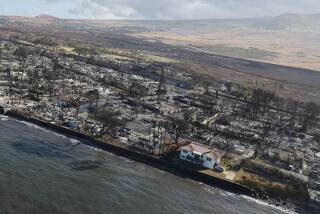Inspectors in Syria may need cease-fires to reach chemical weapons
BEIRUT — Inspectors working under a tight deadline to destroy Syria’s extensive chemical arsenal are off to an encouraging start but may need limited cease-fires to complete their task in the midst of a raging civil war, the head of the international agency overseeing the effort said Wednesday.
The United Nations’ stated goal of eliminating Syria’s chemical weapons by the middle of next year is challenging but “not unrealistic,” Ahmet Uzumcu, director general of the Organization for the Prohibition of Chemical Weapons, told a televised news conference held in the Hague, where the international agency is based.
“We are at the beginning of a difficult process, and there are significant challenges,” Uzumcu said in his first progress report on the mission, which began Oct. 1.
The inspectors must visit about 20 sites across the country, including some where access may be dangerous, officials of the group told reporters. Syrian officials are reported to have concentrated their chemical stockpiles in areas under government control.
“I think the targets could be reached,” the disarmament chief said, explaining that his assessment of meeting various U.N. deadlines was predicated on some degree of cooperation among all parties and the establishment of “temporary cease-fires” to allow access for inspectors.
Thus far, the Syrian government has cooperated in the initial stages of the undertaking, officials said.
“The cooperation has been quite constructive, and I would say that the Syrian authorities have been cooperative,” Uzumcu told reporters.
The current timetable calls on inspectors to eliminate Syria’s ability to produce chemical weapons by Nov. 1, about three weeks from now.
Experts who arrived in Syria last week have already traveled to one site and planned to visit another Wednesday, the chemical disarmament chief noted. Some destruction or disabling of missile warheads, bombs and mixing and filling equipment began last weekend, according to the global disarmament agency.
The Hague-based group, which implements the global Chemical Weapons Convention banning the use and production of chemical arms, is working with the United Nations to manage the large-scale destruction effort in Syria. The U.N. is providing logistical and security assistance in the project.
Last month, the U.N. approved an accelerated plan to destroy Syria’s arsenal by mid-2014 based on a U.S.-Russian accord. The deal helped avert U.S. airstrikes in retaliation for alleged Syrian chemical attacks outside of Damascus on Aug. 21 that killed hundreds, according to U.S. and allied accounts.
The government of Syrian President Bashar Assad denied any role in the Aug. 21 attacks, blaming rebels for the strikes. But Syria agreed to the elimination of its chemical stockpiles. Syria also signaled its intention to become a party to the international convention barring chemical weapons.
The destruction blueprint is considered unprecedented because of its timetable and the fact that it is taking place during a war. Experts are still assessing whether the chemical stockpiles can be neutralized inside the country or whether some material must be moved outside Syria for destruction.
ALSO:
Ousted Egyptian President Mohamed Morsi to stand trial next month
Romanian law ordering death for stray dogs stirs protest worldwide
13 federal police in Mexico accused of being part of kidnapping ring
Twitter: @mcdneville
More to Read
Sign up for Essential California
The most important California stories and recommendations in your inbox every morning.
You may occasionally receive promotional content from the Los Angeles Times.










